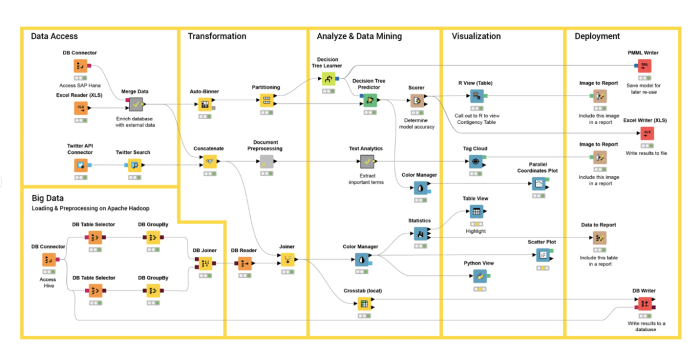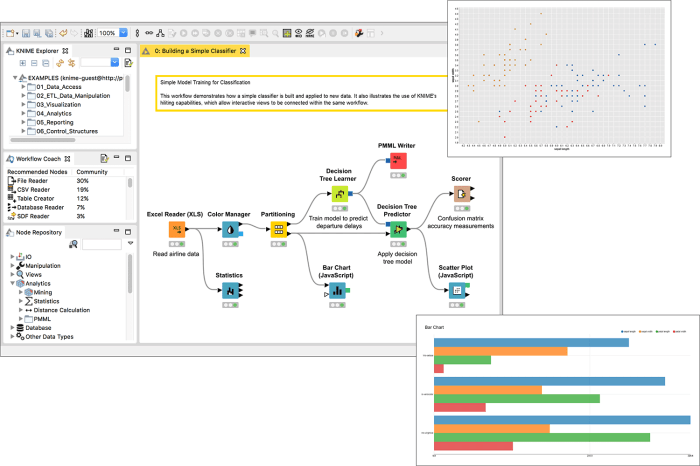KNIME lets users build workflows to automate data analytics tasks, opening a world of possibilities for streamlining and optimizing data analysis processes. This platform empowers individuals and organizations to handle complex data tasks efficiently, turning raw data into actionable insights. Imagine a world where repetitive data tasks like cleaning, transforming, and analyzing data are handled automatically, freeing up valuable time and resources for strategic decision-making. This is the promise of KNIME, a powerful tool that simplifies the data analytics journey.
KNIME’s visual workflow approach makes it incredibly user-friendly, even for those without extensive programming experience. With its drag-and-drop interface, users can connect various nodes to create customized workflows, each tailored to specific data analysis needs. From data sources to data manipulation, visualization, and machine learning, KNIME provides a comprehensive set of tools to handle a wide range of data analysis tasks.
Introduction to KNIME
KNIME (pronounced “knee-may”) is a free and open-source data analytics platform that allows users to build data workflows visually. It’s a powerful tool that can be used to automate data analysis tasks, from data cleaning and transformation to machine learning and reporting.
The core concept of KNIME is based on workflows. Workflows are visual representations of data processing steps. Each step in the workflow is represented by a node, and nodes are connected by lines that represent the flow of data. This visual approach makes it easy to understand and manage complex data analysis processes.
Benefits of using KNIME
Using KNIME for data analytics tasks offers several advantages:
- Visual Workflow: KNIME’s visual workflow approach makes it easy to understand and manage complex data analysis processes. Users can drag and drop nodes to build workflows, and the visual representation makes it easy to see how data is processed. This visual approach is particularly helpful for beginners who are new to data analytics.
- Wide Range of Nodes: KNIME offers a wide range of nodes for various data analytics tasks. There are nodes for data cleaning, transformation, visualization, machine learning, and more. This extensive library of nodes makes it possible to perform a wide variety of data analysis tasks within KNIME.
- Open Source: Being open-source, KNIME allows users to access and modify its source code. This gives users greater flexibility and control over the platform. Additionally, the open-source nature of KNIME fosters a vibrant community of users and developers who contribute to the platform’s development.
- Extensible: KNIME is highly extensible, meaning users can create custom nodes to perform specific tasks or integrate with other software. This extensibility makes KNIME a versatile tool that can be adapted to various data analysis needs.
- Easy to Learn: KNIME is relatively easy to learn, even for users with limited data analytics experience. The platform has a user-friendly interface and provides extensive documentation and tutorials. This makes it an accessible tool for individuals and organizations of all sizes.
Automating Data Analytics Tasks
KNIME is a powerful platform that empowers you to automate data analytics tasks, saving you time and effort while increasing efficiency and accuracy. By creating workflows, you can streamline repetitive processes, handle large datasets, and extract valuable insights from your data.
Types of Tasks Automated with KNIME Workflows
Automating data analytics tasks using KNIME workflows can significantly improve your productivity and accuracy. Here are some of the tasks that can be automated:
- Data Cleaning and Preparation: KNIME offers a wide range of nodes for cleaning, transforming, and preparing data for analysis. This includes handling missing values, standardizing formats, and removing duplicates.
- Data Exploration and Visualization: Visualizing data is crucial for understanding patterns and trends. KNIME allows you to create interactive dashboards and visualizations to gain insights from your data.
- Data Modeling and Machine Learning: KNIME provides a comprehensive library of machine learning algorithms for tasks like classification, regression, clustering, and anomaly detection. You can easily build and deploy models using these algorithms.
- Data Integration and Transformation: KNIME can connect to various data sources, including databases, spreadsheets, and cloud services, to extract and integrate data from multiple sources.
- Report Generation and Sharing: KNIME allows you to generate reports and dashboards that can be easily shared with stakeholders, providing a clear and concise view of your findings.
Real-World Use Cases of KNIME Automation
KNIME automation has numerous real-world applications across various industries. Here are some examples:
- Customer Relationship Management (CRM): Businesses can use KNIME to automate customer segmentation, churn prediction, and personalized marketing campaigns based on customer data.
- Financial Analysis: Financial institutions can leverage KNIME to automate risk assessment, fraud detection, and portfolio optimization by analyzing financial data.
- Healthcare: KNIME can be used to automate patient data analysis for disease prediction, drug discovery, and personalized treatment plans.
- Manufacturing: Manufacturers can utilize KNIME to optimize production processes, predict equipment failures, and improve quality control by analyzing sensor data and production records.
- Research and Development: Scientists and researchers can employ KNIME to automate data analysis for scientific experiments, drug discovery, and materials science research.
Advantages of Automating Data Analytics Tasks with KNIME
Automating data analytics tasks using KNIME offers several advantages:
- Increased Efficiency and Productivity: KNIME allows you to automate repetitive tasks, freeing up your time for more strategic work.
- Improved Accuracy and Consistency: By automating processes, you reduce the risk of human errors and ensure consistency in your analysis.
- Enhanced Collaboration and Reproducibility: KNIME workflows can be easily shared and collaborated on, enabling teams to work together effectively and reproduce results.
- Faster Time to Insights: Automating data analysis tasks allows you to gain insights from your data much faster, enabling you to make better decisions quicker.
- Scalability and Flexibility: KNIME workflows can be scaled to handle large datasets and complex analyses, and they can be easily adapted to changing requirements.
The Future of KNIME: Knime Lets Users Build Workflows To Automate Data Analytics Task
KNIME, a powerful open-source data analytics platform, is constantly evolving to meet the ever-changing demands of the data landscape. As we move forward, the future of KNIME holds exciting possibilities, driven by emerging technologies and the need to address complex challenges in data analysis.
Impact of Emerging Technologies on KNIME
The rapid advancements in artificial intelligence (AI), machine learning (ML), and cloud computing are shaping the future of data analytics, and KNIME is well-positioned to leverage these technologies.
- AI and ML Integration: KNIME is expected to seamlessly integrate with AI and ML algorithms, enabling users to build more sophisticated and automated workflows. This integration will allow for advanced data analysis tasks, such as predictive modeling, anomaly detection, and natural language processing, all within the KNIME environment.
- Cloud-Based Analytics: The rise of cloud computing has transformed data storage and processing, and KNIME is embracing this trend. KNIME’s cloud integration will allow users to scale their data analysis projects, access powerful computing resources, and collaborate more effectively. This will empower users to handle larger datasets and perform more complex analyses, even with limited local computing power.
- Data Visualization Enhancements: KNIME’s visualization capabilities will continue to improve, offering more interactive and informative ways to present data insights. Advanced visualization techniques, such as 3D visualizations and interactive dashboards, will provide a more engaging and comprehensive understanding of data trends and patterns.
Addressing Future Challenges in Data Analytics, Knime lets users build workflows to automate data analytics task
The future of data analytics will be characterized by increasing data complexity, growing data volumes, and the need for real-time insights. KNIME is poised to address these challenges through innovative features and functionalities.
- Enhanced Data Handling: KNIME will likely introduce advanced data handling techniques to manage large and complex datasets efficiently. This includes features for data cleaning, transformation, and integration, allowing users to work with diverse data sources and formats seamlessly.
- Real-Time Data Analysis: The demand for real-time insights is growing rapidly, and KNIME is expected to evolve to support real-time data analysis. This will involve integrating with streaming data sources and developing algorithms that can process data as it arrives, enabling faster decision-making and proactive problem-solving.
- Advanced Automation: KNIME’s automation capabilities will continue to expand, allowing users to build even more sophisticated workflows. This includes features for automatic data collection, data preparation, model training, and deployment, streamlining the entire data analytics process and freeing up data scientists to focus on higher-level tasks.
The future of data analytics is undeniably intertwined with automation, and KNIME stands at the forefront of this revolution. Its ability to empower users, regardless of their technical expertise, to automate complex tasks is truly transformative. Whether you’re a seasoned data scientist or a business professional seeking insights from data, KNIME offers a powerful solution for simplifying, streamlining, and accelerating your data analysis journey. As the world of data continues to evolve, KNIME will undoubtedly play a pivotal role in shaping the future of data analytics, making it more accessible, efficient, and impactful than ever before.
 Standi Techno News
Standi Techno News

